Description of species and varieties of euonymus
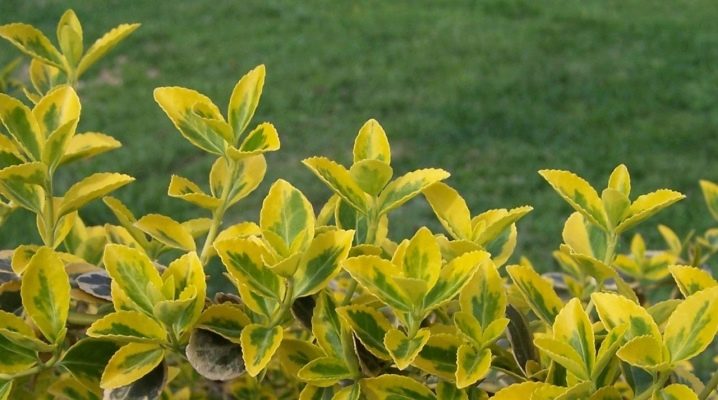
Euonymus is a plant of the euonymus family, which is very often used in landscape design. Many types of ornamental shrubs are used to create hedges, fences and garden plots. In this article, we will describe the most popular varieties of indoor and garden spindle trees, and also consider interesting options for their use in landscape design.
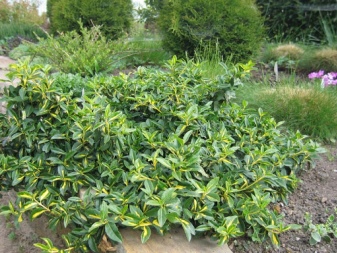
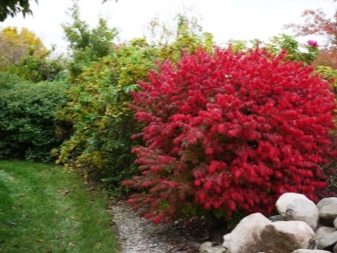
Indoor varieties
Almost all types of euonymus are grown only outdoors, but there are special varieties that can be planted in pots and grown indoors. There are only two types of indoor shrubs - Japanese and rooting. Let's take a closer look at the description of euonymus suitable for growing inside the house.
Japanese
Japanese variegated euonymus is a versatile shrub that can be planted both in pots and outdoors. All varieties of Japanese euonymus have a fluffy and colorful crown, strewn with many two-colored leaves with a dark center and light edges. Evergreen bushes produce fleshy foliage and bear fruit, but their berries are unsuitable for food, as in most euonymus species.
An indoor shrub grows 15-20 centimeters per year, and in nature the plant reaches 7 meters in height and blooms very beautifully, but in the conditions of apartments it throws flowers very rarely. The reason is that for the formation of buds, the euonymus needs coolness for a long time. In order for a decorative bush to bloom in an apartment, it needs to be indoors or outdoors at a temperature of 2 to 10 degrees for 60 days.
Even without flowers and fruits, Japanese euonymus fits perfectly into the interior of any apartment. The most popular varieties of this plant are Marike, Bravo and Ecstasy.
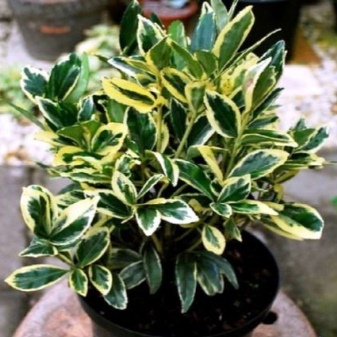
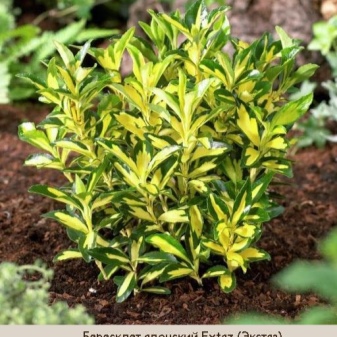
Rooting
The rooting variegated euonymus or forchuna is a frost-resistant bush that feels comfortable both outdoors and indoors. It is a stunted species of evergreen ornamental plant, dotted with small leaves with a smooth and shiny surface. Foliage can be of a solid bright green color or with a contrasting light border. Under certain conditions, the rooting euonymus produces small yellowish-green flowers.
The dwarf creeping bush grows to a maximum of 55-65 cm in height, but the spreading branches sometimes reach 3 meters in length. Some rooting euonymus change the shade of the leaves during their life, for example, the Gratsilis variety initially produces light yellow leaves, which gradually turn red with a white outline. Another shade-changing bush is Emerald Gold, in summer its leaves are creamy with yellow spots, and in autumn they turn red.
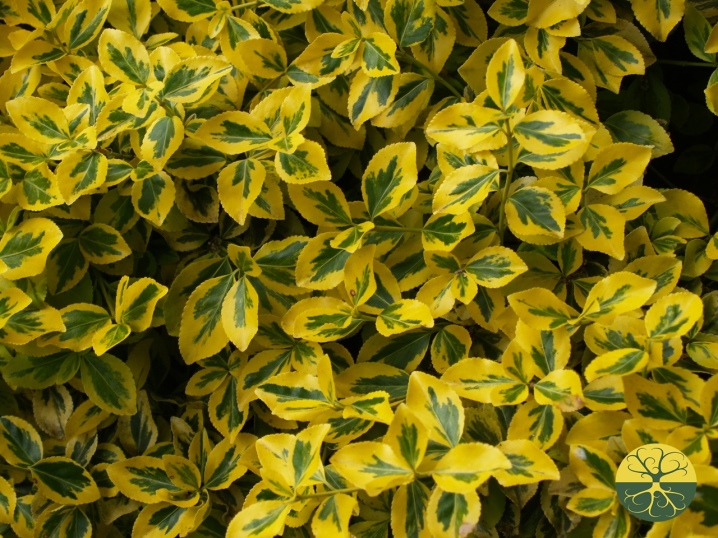
Popular street views
A tree plant of the euonymus family is often used in landscape design, not only because of its external qualities, but also because of the wide variety of species. In total, there are 142 varieties of euonymus, of which 20-25 types of bushes grow on the territory of Russia. The most popular types of ornamental plants in the middle lane are the warty and European bush.
The common euonymus is most often used as a hedge, but some varieties are also used for other purposes, for example, for the design of parks, gardens and summer cottages.
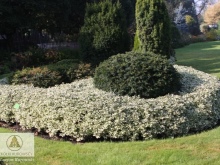


Ornamental shrubs are widespread in central Russia due to their high frost resistance and unpretentiousness. For example, a curly type of euonymus, intended for braiding fences, does not need shading - it feels good under the sun's rays, and grows very slowly in the shade. The yellow variety tolerates drought well, because in the wild it grows in loose and dry soil. Copeman's euonymus has a long lifespan - the plant can live from 25 to 30 years, so it is often used to create borders and ridges.
Each type of ornamental bush has its own characteristics and advantages that can be used for landscaping a garden, park or summer cottage. We propose to consider a list of the most common varieties of euonymus used for landscape design.
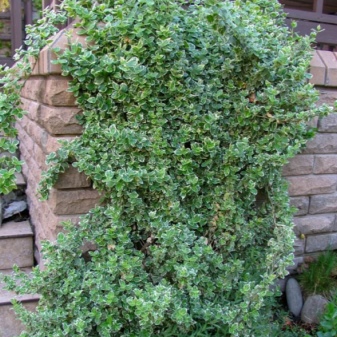
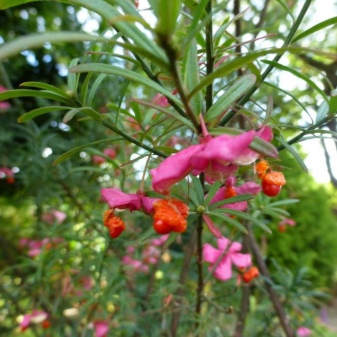
European
European euonymus, which is also often called "bruslin", - This is a small tree, in appearance more like a dense bush. The foliage of the plant is usually colored in different shades of green - from variegated to dark colors. The shrub reveals all its beauty in the fall, when its crown is painted in a rich purple hue.
The fruits of the European euonymus deserve special attention - the berries on the bush turn red when ripe. The most popular variety of trees is "Red Cascade", the leaves of which turn into a rich crimson color with the onset of autumn. The bright color distinguishes the bush from other plants, so it is more often used for decorating gardens than for creating a hedge.

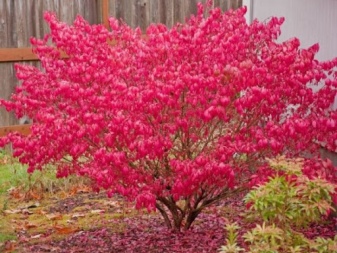
Warty
Warty euonymus is an indigenous forest inhabitant on the territory of Russia. A distinctive feature of the plant is the numerous "warts" that cover the entire surface of the shoots. In the spring, the bush releases inflorescences with a strange "mouse" smell, which by autumn turn into pink seed pods. At the same time, the foliage, which was green all summer, takes on a light red hue.
The maximum height of an ornamental warty bush is 2 meters, the crown is lush and densely covered with medium-sized foliage. During the autumn color change, the leaves do not fall from the branches - the shrub variety keeps them until frost.
Decorative euonymus is beautiful, lush and unpretentious in care, therefore it is often used by gardeners to decorate parks and summer cottages.
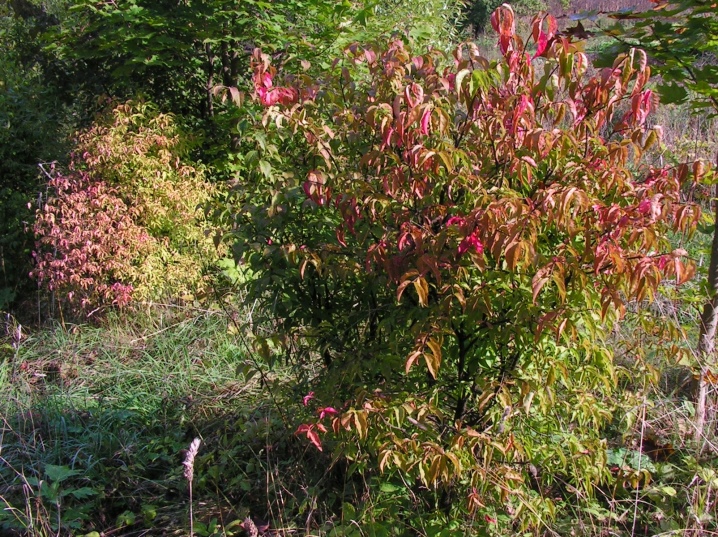
Fortune
One of the most popular types of euonymus, cultivated throughout the country, it is suitable both for the Moscow region and for the eastern regions. Fortune is famous for a wide variety of varieties and an unusual crown shape - the branches of the bush do not grow up, they cover the soil. The evergreen euonymus has creeping branches with dense and dense foliage, stretching for several meters around the trunk.
Most varieties of the "Fortune" species have white-green, yellow-green or completely green leaves. Some varieties take on a pale pink hue in winter, contrasting sharply with the white snowdrifts. The most common varieties of the undersized plant are Harlequin, Sunspot and Emerald Haiti.
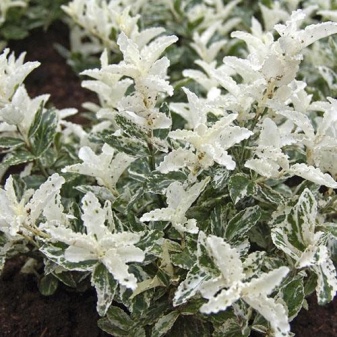
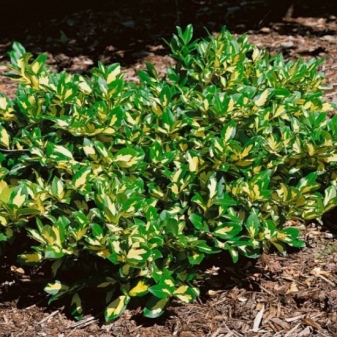
Winged
A bright decorative tree with fiery foliage, which received two more names for its unusual color - "burning bush" and "burning bush". The winged euonymus grows slowly and reaches a height of no more than 1.9-2.2 meters. Its crown is spreading, but all branches are straight and neat. An important distinguishing feature of the species is the dense ribbed growths on the bark, from which the plant got its name.
The “fire bush” is not always painted in bright shades - it remains green all summer long, and in the first month of autumn it changes the color of the leaves in a short period of time. The small-flowered bush has no particular decorative value during the flowering period, however, it provides the garden with bright colors in the winter, because purple berries remain on the branches. The most popular varieties of winged euonymus are Chicago Fire, Compact, Fireball and Compactus.
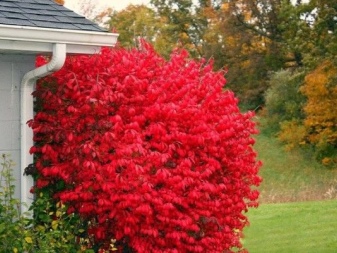
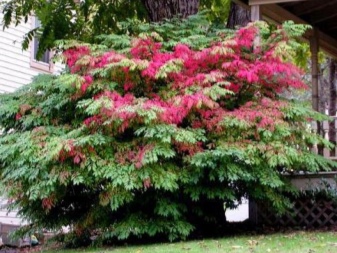
Semenova
A small evergreen shrub that grows up to a maximum of 1 meter in height. The crown of the plant is dense and lush, covered with oval green leaves about 5 centimeters long. The branches of the plant are spreading and creeping - they are perfectly intertwined with nearby euonymus, therefore they are often planted as a hedge.
The Semyonov shrub is not afraid of temperature changes, easily tolerates frosts and can grow in shaded areas of the garden.
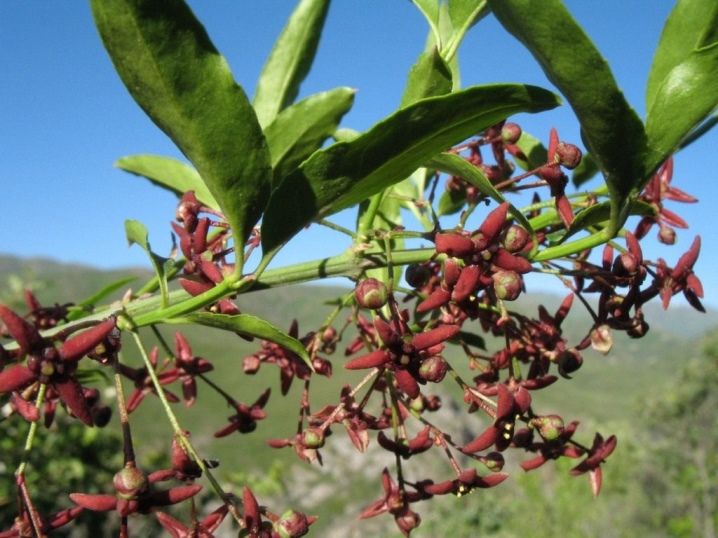
Dwarf
Dwarf spindle tree is a rare plant listed in the Red Book. It grows mainly in China and Europe, rarely in Russia. A small shrub barely reaches 1 meter in height; its branches have an unusual four-sided shape. It begins to bloom in early summer, but very rarely bears fruit and practically does not propagate by seeds.
A frost-resistant plant does not like excess sunlight - it must be planted in moderately shaded areas of the garden.
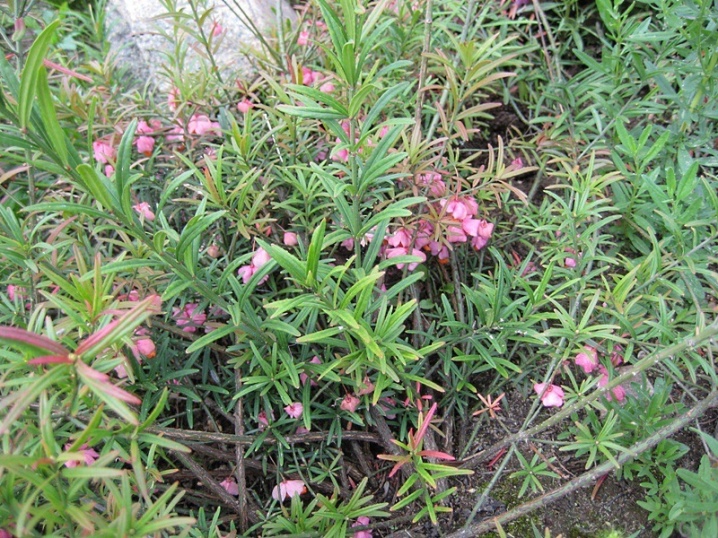
Maaka
This type of bush is often considered a tree, because its central branch grows larger than others, resembling a real trunk. Maaka, unlike other varieties, is a deciduous plant and grows up to 11 meters - this is one of the highest growth rates among the members of the family. Its foliage is also large - the length of the leaf sometimes reaches 12-14 cm, and the width is from 1 to 3 cm.
Maaka loves sunlight and does not need shading, which is why it is often planted as a separate element of the garden.
The shrub thrives best in moist, low acid soil, but it can grow in sandy soil as well.

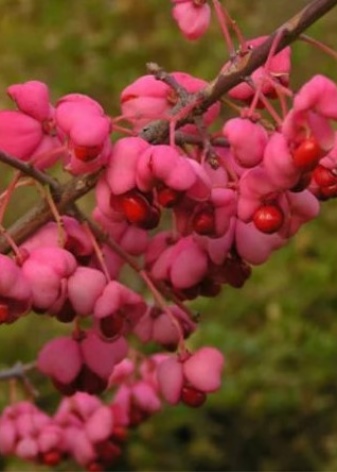
Large-winged
Large-winged spindle tree belongs to deciduous trees - it grows up to 8-9 meters in height. Quite large leaves grow on flattened purple or dark green twigs - 5 to 15 cm in length and 2 to 7 cm in width. At the end of spring, the tree releases inflorescences, which contain from 10 to 22 flowers. The plant reproduces by seeds, which ripen in a capsule with four open blades.
The large-winged variety is resistant to cold weather, therefore it grows successfully in the northern regions of the country. On the trees in the fall, bright fruit-boxes ripen, which distinguish them from other plants. Decorative euonymus is most often used for landscaping parks and large gardens.
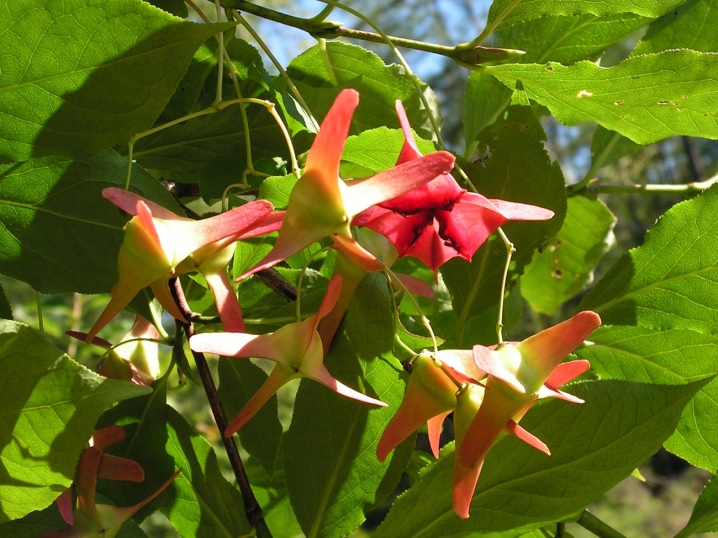
Groundcover
A dwarf variety of euonymus, the height of which does not exceed 35-40 cm. At the same time, the spreading crown of the bush spreads along the ground for several meters around the trunk, densely covering the soil, stones and stumps with numerous branches. The creeping shrub is used in landscape design as a kind of "carpet" covering the ground.
Ground cover euonymus is most often used to create a continuous covering of lawns and alpine hills. The branches of the bush cover 12-14 sq. m of soil.
The spreading plant loves medium shade and moist soil.
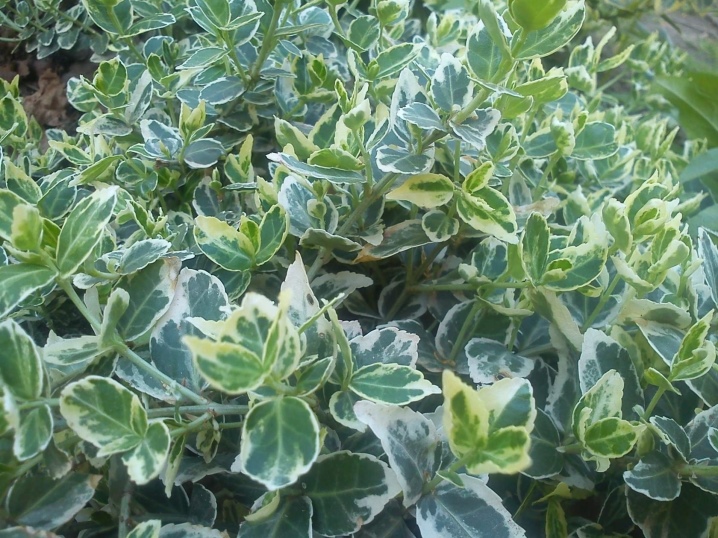
Flat petiolate
Sakhalin flat-peaked euonymus is a small tree or bush with a sparse crown. The trunk and young shoots of the variety have an olive tint, the smooth bark is covered with a bluish bloom. The plant was first cultivated in China, from where it spread throughout the world.
The ornamental tree reaches 3 meters in height and leaves enormous foliage - up to 20 cm in length and up to 10 cm in width. During the flowering period, the flat-peted variety produces flower stalks with up to 30 flowers. The inflorescences are not only beautiful, but also large - their length is up to 17 cm. In landscape design, a tree can be both a free-standing element and the central part of a plant composition.
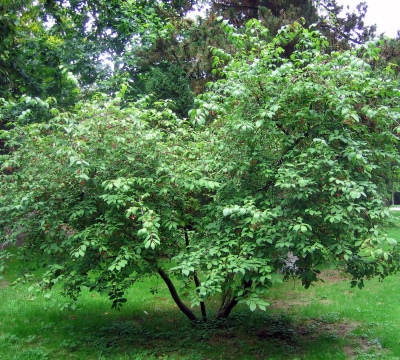
Suberic
An ornamental shrub, like most plants of the euonymus family, comes from China. Cork euonymus is a frost-resistant bush that grows to a maximum of 2.3-2.6 m in height. Strong branches form many shoots and forks, so the crown of plants is thick and fluffy. The name of the plant comes from the beautiful cork bark that forms a strong protective layer on mature shrubs.
The cork bush is picky about the level of soil moisture - for comfortable growth it needs a sufficiently moist soil, but the plant may die from excess moisture. Euonymus grows best in moist, moderately alkaline soil. The amount of sunlight does not affect the development of the shrub - it grows equally well both in the sun and in the shade.
In landscape design, the plant looks best as a stand-alone garden element.
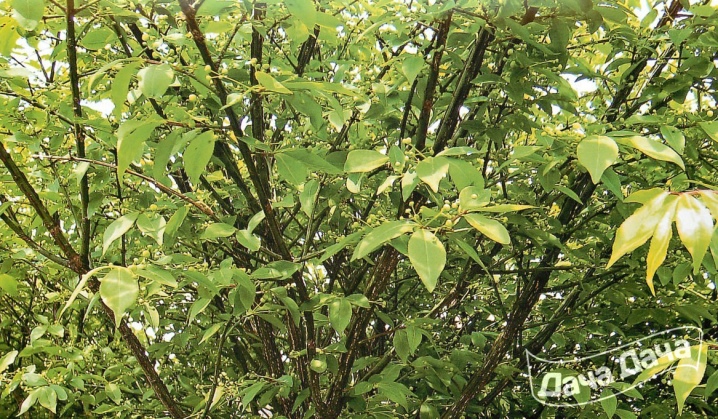
Sacred
A small type of ornamental shrub, the peculiarity of which lies in the shape of the crown - it independently takes the form of a ball with a diameter of 1.2-1.5 meters. The sacred euonymus is very dense due to the frequent branching of the shoots. In summer, the foliage of a round bush has a brown hue, and in autumn, during the ripening of the fruits, the surface of the leaves becomes a deep red color.
The plant loves dry soil and abundant sunlight, and grows much more slowly in shaded areas.
In landscape design, the sacred gardeners use euonymus in different ways - they create a hedge from it, decorate flower beds and plant it as a separate element of the garden.

Maksimovich
A very large species of euonymus, which is divided into two varieties: tree and shrub. The bush grows up to 4 meters high, and the tree can grow up to 8 meters. Maksimovich's euonymus is a deciduous variety that changes the color of the leaves at different times of the year. The plant produces flowers in the last month of spring and continues to bloom for 25-30 days. Throughout the summer, the shrub is covered with light green foliage, changing its color to a bright red hue in September. After the leaves fall, the red berries that densely cover the branches retain their decorative appearance.
For the shrub to feel comfortable, it must be planted in alkaline soil. The plant does not like moisture - it prefers dry and loose soil. Maksimovich's euonymus grows very slowly - its first flowering begins 10 years after planting in open ground.
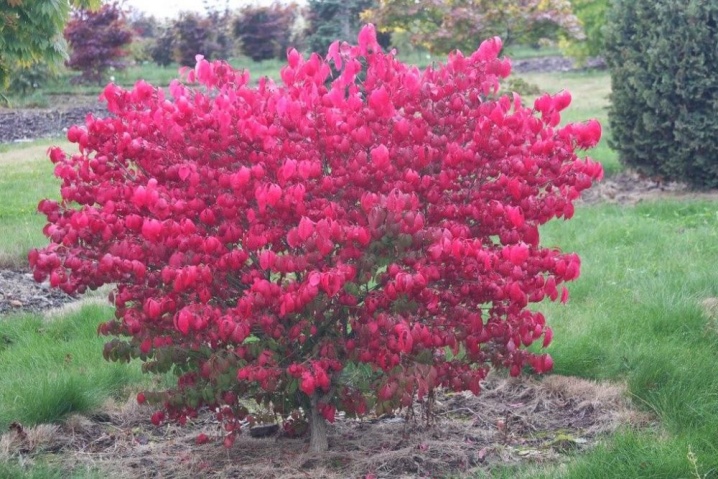
Beautiful examples of use in landscaping
The assortment of ornamental plants with a colorful crown makes it possible to use euonymus as a separate element in the garden and as part of a flower bed. Consider some interesting options for using shrubs in landscape design.
- "Rug" from the bush. Dwarf ground cover bushes fit perfectly into empty flower beds.
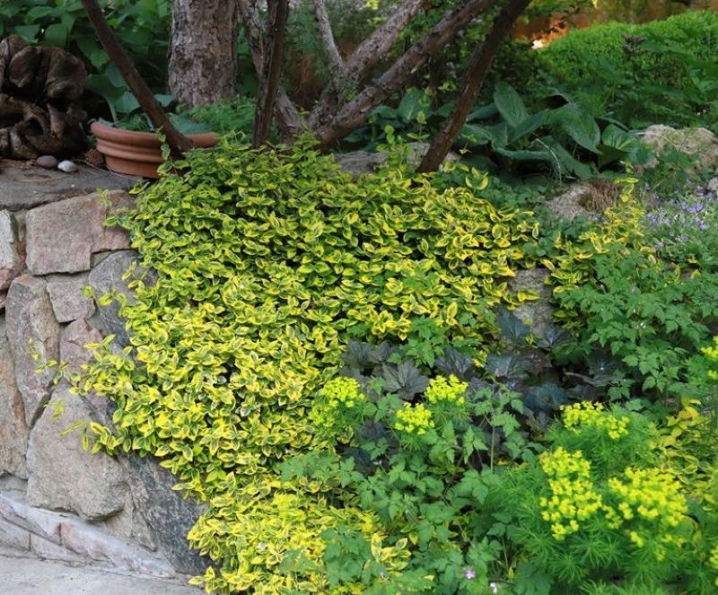
- Hedge. Spindle trees with a fluffy crown and dense foliage make it possible to create a real, impenetrable "fence" around a house or a summer cottage, and can also be used for zoning a park.
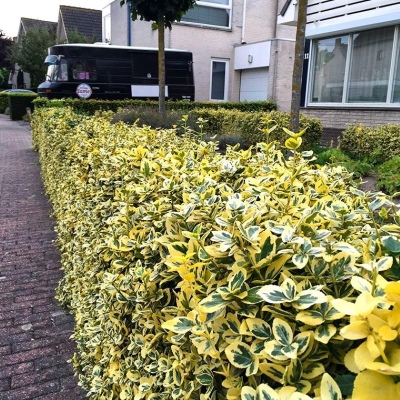
- Border. Some undersized bush varieties look great as a dividing border.

- Mix with contrasting conifers. Spindle trees go well with conifers.
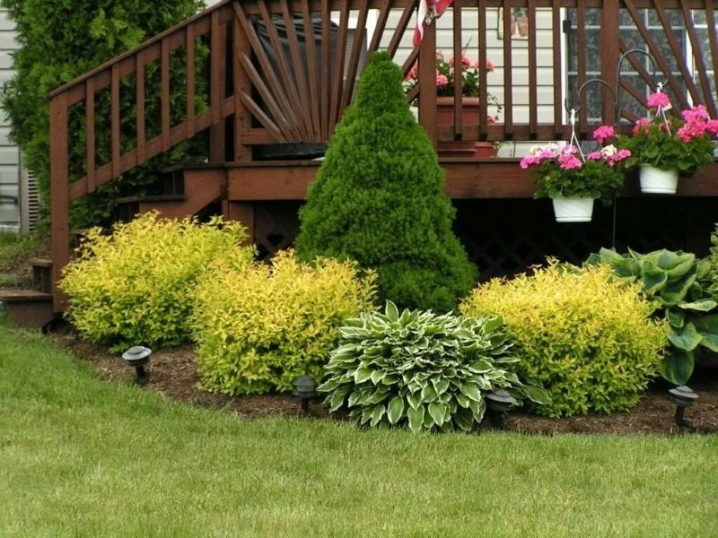



































































The comment was sent successfully.